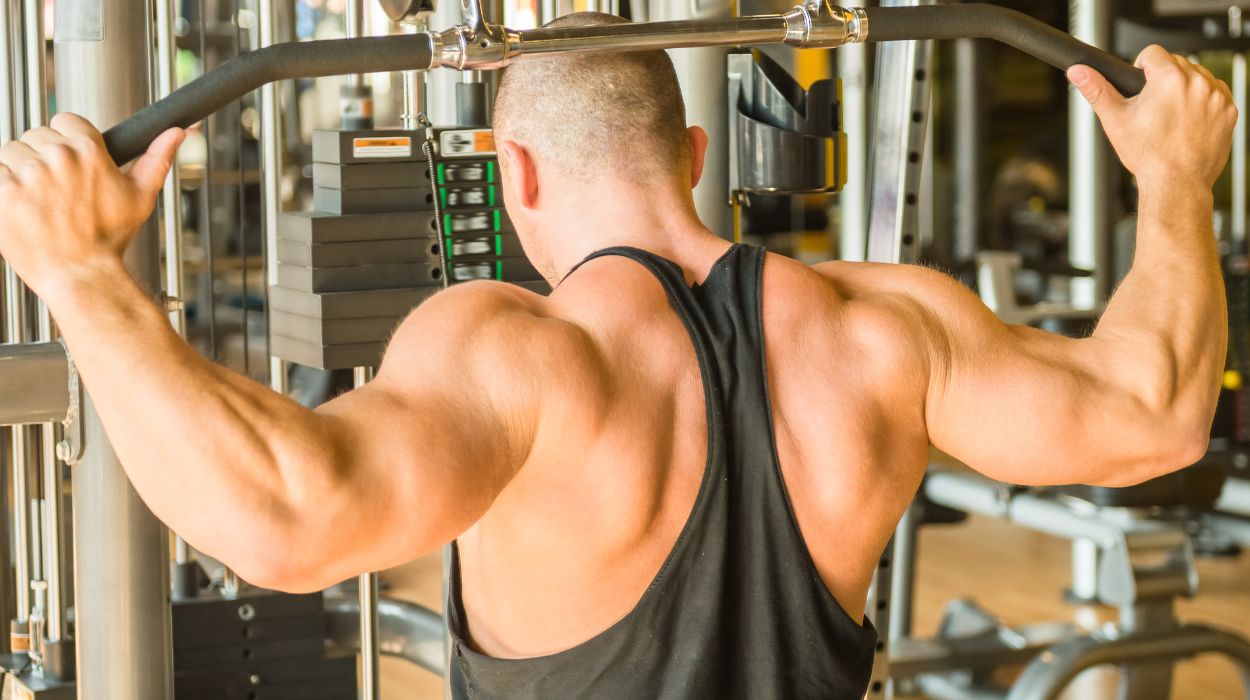
Pushing shoulder exercises can help you improve your strength, power, and posture. These movements involve pushing a weight away from your body, such as an overhead press, a bench press, and push-ups. On the other hand, pulling exercises move closer to the body and include pull-ups and deadlifts.
In this article, we will show you five of the best pushing shoulder workouts that you can do in 2024. We will also explain the shoulder muscles being worked, the benefits offered, and how to do them safely and effectively. Let’s get started.
Best Pushing Shoulder Exercises 2024
The best pushing shoulder exercises to try in 2024 include:
- Seated Dumbbell Overhead Press.
- Kneeling Barbell Landmine Press.
- Seated Dumbbell Lateral Raise.
- Barbell Bench Press.
- Standing Barbell Military Press.
Each of these exercises works the anterior and medial deltoids and can help you improve strength and muscle size in the shoulders when done consistently with progressive overload.
Best Pushing Shoulder Exercises 2024
There are many different shoulder exercises to consider for building strength. These are some of the best that you can do without using a machine, but there are many others to consider.
Seated Dumbbell Overhead Press
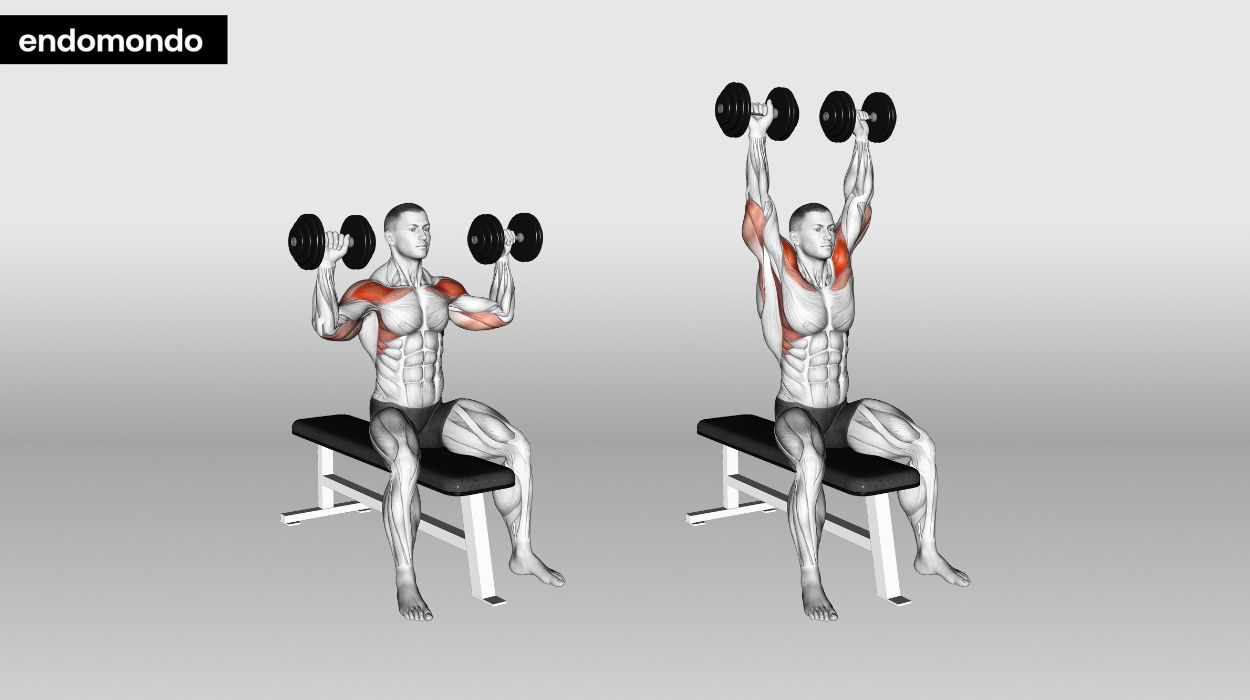
One of the most effective dumbbell shoulder exercises for developing the deltoids[1] is the seated dumbbell shoulder press. The dumbbell press also works the triceps, the upper trapezius, and the core. This exercise can improve your shoulder stability and mobility.
How to do:
- Sit on a bench with back support and hold a dumbbell in each hand at shoulder level, with your palms facing forward.
- Engage your core and keep your back straight.
- Press the dumbbells over your head until your arms are fully extended, but do not lock your elbows.
- Lower the dumbbells back to the starting position in a controlled manner.
- Repeat for the desired number of reps.
Tips:
- Keep your head in a neutral position, and do not arch your back or neck.
- Do not let the dumbbells drift too far forward or backward, as this can cause shoulder impingement[2] or injury.
- Choose weights that allow you to do the motion but provide a challenge. A good way to gauge this is by noting your fatigue during the last few reps of the set.
- Breathe out as you press the dumbbells up, and breathe in as you lower them down.
- You can also do this exercise standing. Make sure you have a stable base and do not sway your body or arch your back.
Optimal Sets and Reps: Try doing three to four sets of eight to 12 reps, with 60 to 90 seconds of rest between sets. If you opt to use a heavier weight; be sure to complete fewer reps in each set and allow more time for resting between. For each of these exercises, experiment to see what works best for you and the weights you’re using.
Kneeling Barbell Landmine Press
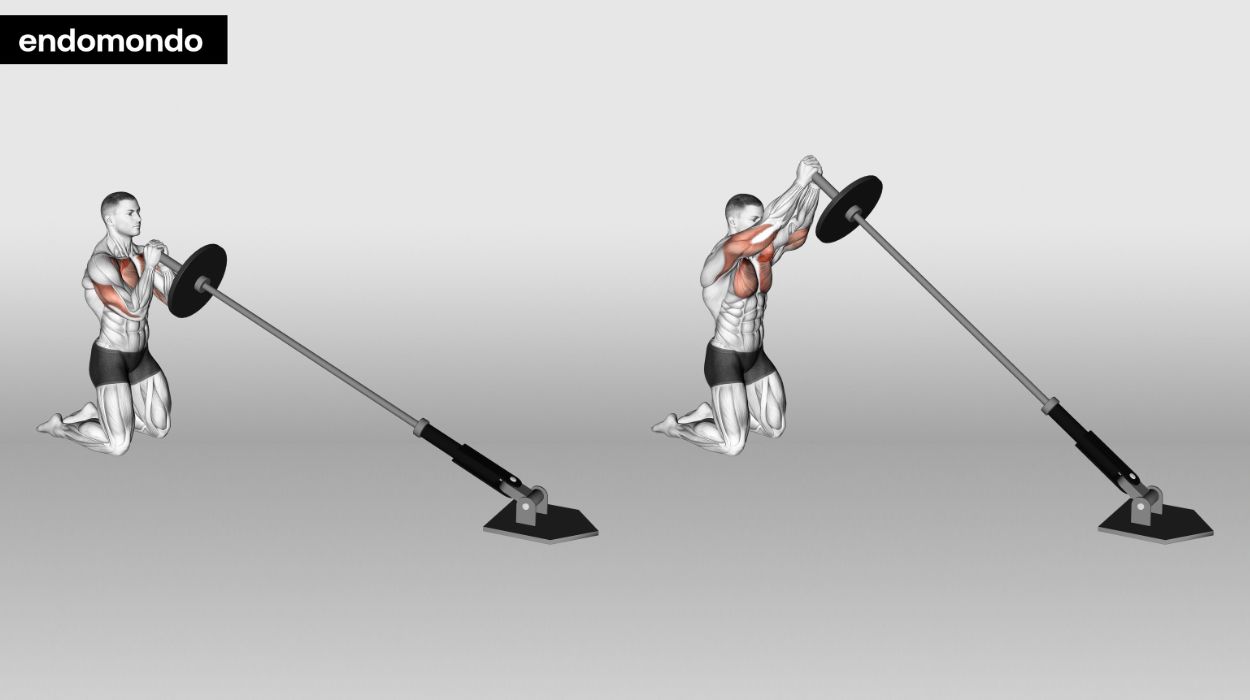
This shoulder press exercise involves pressing a barbell from a diagonal angle. This angle may provide a lower injury risk[3] than pressing directly overhead.
It’s a great push-up for shoulder exercise that works many muscles around your shoulder. It can help you improve your shoulder stability, coordination, and power.
How to do:
- Set up a barbell in a landmine attachment or wedge one end of the barbell in a corner of the room.
- Kneel on the floor and hold the other end of the barbell with one hand at shoulder level. Keep your elbow bent and your palm facing in.
- Engage your core and keep your back straight.
- Press the barbell up and away from your body until your arm is fully extended, but do not lock your elbow.
- Lower the barbell back to the starting position in a controlled manner.
- Repeat for the desired number of reps, then switch sides.
Tips:
- Keep your head in a neutral position.
- Do not let the barbell drop too low or too high.
- Breathe out as you press the barbell up, and breathe in as you lower it down.
- You can also do this exercise standing, but be sure to engage your core and give yourself a stable base.
Optimal Sets and Reps: Aim for three to four sets of eight to 12 reps per side; allow 60 to 90 seconds of rest between sets.
Seated Dumbbell Lateral Raise
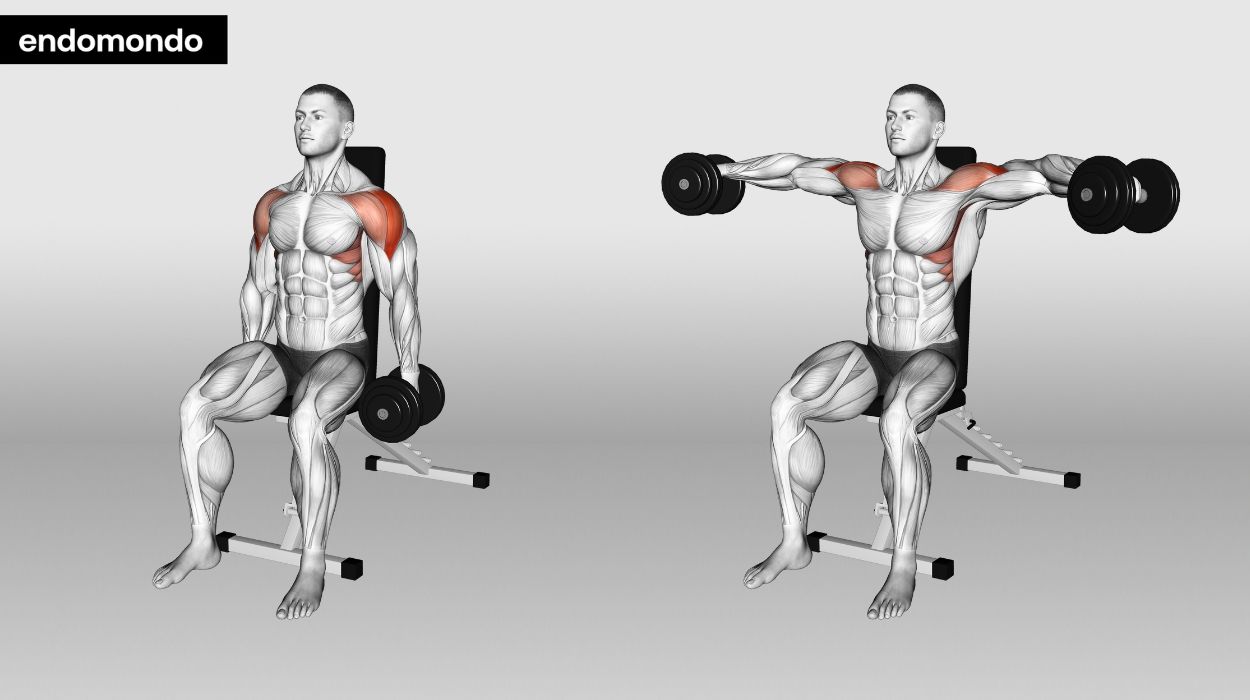
The seated dumbbell lateral raise might be the best push-up for shoulders you can find. It targets the medial deltoids[1] but also engages the anterior deltoids, the trapezius, and parts of the rotator cuff. This exercise can help you increase your shoulder width, definition, and health.
How to do:
- Sit on a bench with back support and hold a dumbbell in each hand at your sides, with your palms facing in.
- Engage your core and keep your back straight.
- Raise the dumbbells out to your sides until they are parallel to the floor; keep a slight bend in your elbows and your wrists neutral.
- Lower the dumbbells back to the starting position in a controlled manner.
- Repeat for the desired number of reps.
Tips:
- Keep your head straight.
- Do not raise the dumbbells too high or too low to avoid shoulder impingement or injury.
- Breathe out as you raise the dumbbells and breathe in as you lower them.
- You can also do this exercise standing, but be sure to engage the core for stability.
Optimal Sets and Reps: Aim for three to four sets of 10 to 15 reps; allow 60 to 90 seconds of rest between sets.
Barbell Bench Press
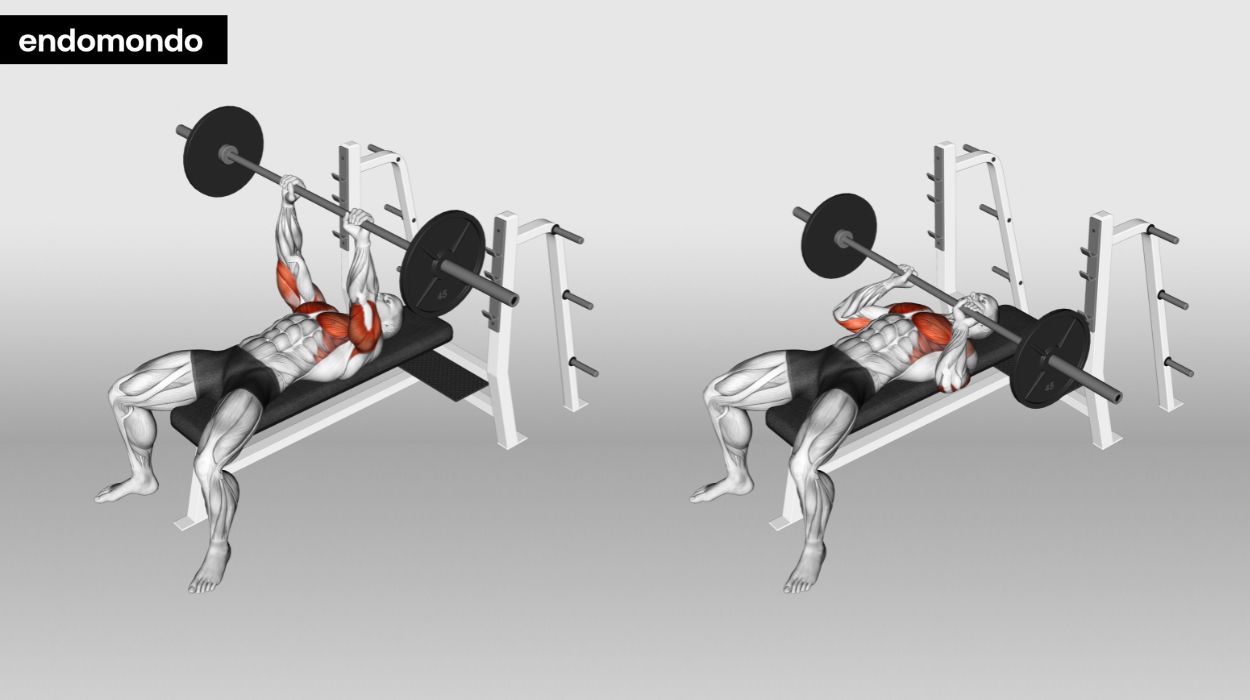
The barbell bench press is a classic compound exercise that works almost all of your upper body,[4] including the chest, shoulder,[5] triceps, upper back, and core. This exercise is one of the best choices for a shoulder and bicep workout. It can help you develop your upper body strength, size, and power.
How to do:
- Lie on a flat bench and hold a barbell with a medium grip. Position your arms slightly wider than shoulder-width apart, above your chest, with your arms fully extended. Do not lock your elbows.
- Engage your core and keep your feet flat on the floor.
- Lower the barbell to your chest, keeping your elbows tucked in and your wrists straight.
- Press the barbell back up to the starting position, using your chest, triceps, and shoulders to push the weight.
- Repeat for the desired number of reps.
Tips:
- Keep your head straight up and chin down.
- Do not bounce the barbell off your chest or let it touch your neck, as this can cause injury.
- Avoid arching your back while lying on the bench.
- Breathe out as you press the barbell up, and breathe in as you lower it down.
- You can also do this exercise with dumbbells or on an incline or decline bench to target different parts of the chest and shoulders.
Optimal Sets and Reps: Aim for three to four sets of six to 10 reps, with 60 to 90 seconds of rest between sets.
Standing Barbell Military Press
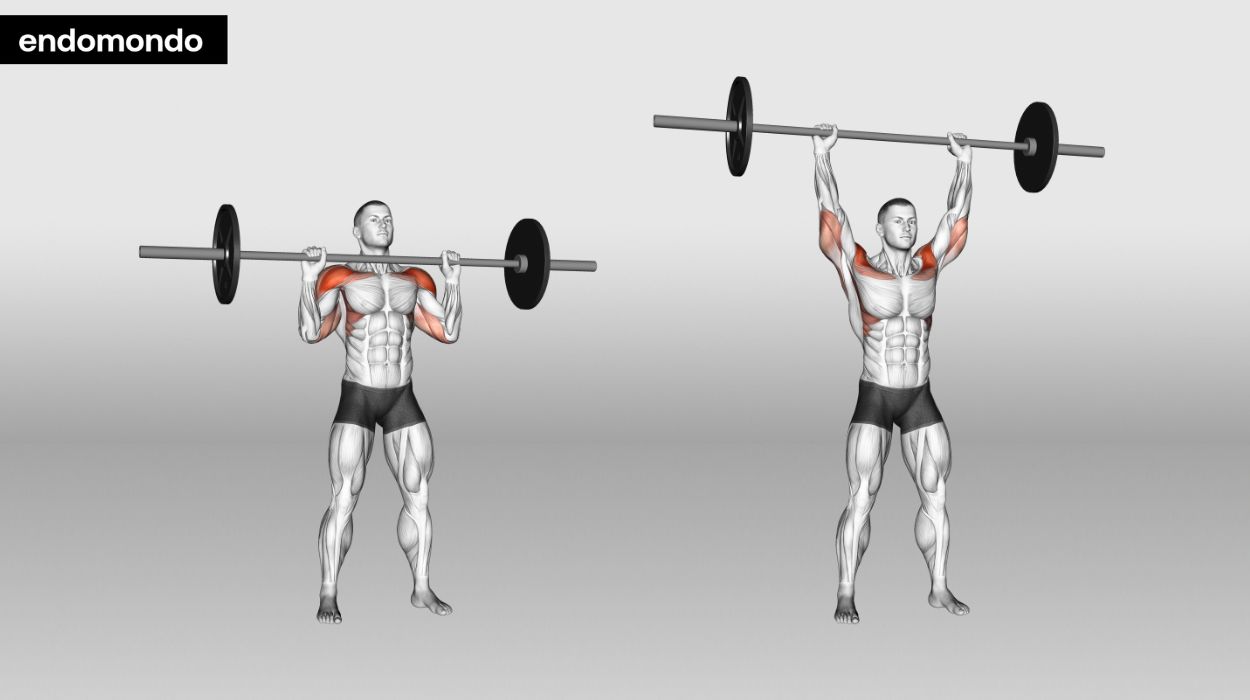
The standing barbell military press is another compound exercise that works the anterior and medial deltoids. It also engages the triceps, the upper back, and the core.[6] This standing push press exercise can help you improve your shoulder stability, mobility, and overhead strength.[7]
How to do:
- Stand with your feet shoulder-width apart and hold a barbell with a medium grip. Position your arms to be slightly narrower than shoulder-width apart, in front of your shoulders, with your palms facing forward.
- Engage your core and keep your back straight.
- Press the barbell up over your head until your arms are fully extended, but do not lock your elbows.
- Lower the barbell back to the starting position in a controlled manner.
- Repeat for the desired number of reps.
Tips:
- Keep your head straight.
- Do not let the barbell drift too far forward or backward.
- Breathe out as you press the barbell up, and breathe in as you lower it down.
- You can also do this exercise seated or with dumbbells to vary the difficulty and the angle of the press.
Optimal Sets and Reps: Aim for three to four sets of eight to 12 reps, with 60 to 90 seconds of rest between sets.
What Shoulder Muscles Do Pushing Shoulder Exercises Work?
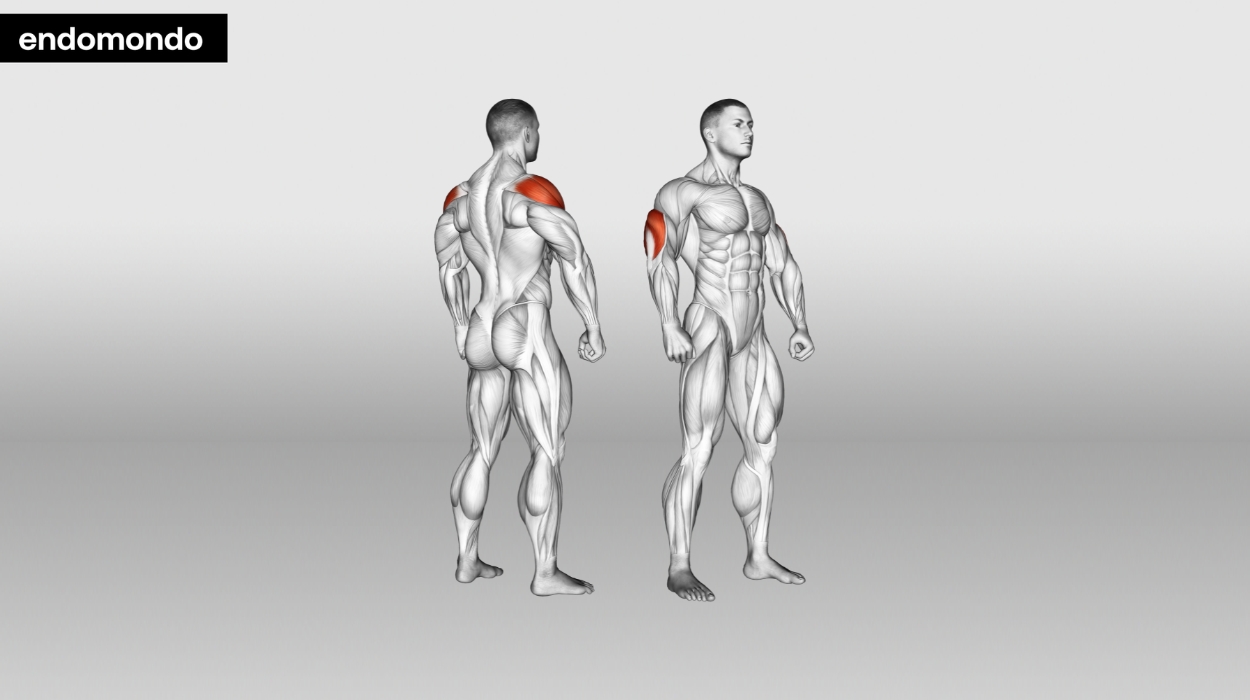
Push day shoulder exercises work mainly the anterior and medial deltoids.[8] These are the muscles that form the front and side of the shoulder.
The anterior deltoids raise the arm in front, and the medial deltoids raise the arm to your side. These muscles also help stabilize the shoulder joint and prevent injuries.
These types of shoulder exercises also often work the triceps,[9] the muscles that extend the elbow and assist in shoulder extension. Some exercises also work the chest, the upper back, and the core muscles.
Benefits Of Pushing Shoulder Exercises
A push shoulder workout can improve your ability to push, press, and lift heavy objects including furniture or luggage. They can also help you perform better in sports and activities that use your upper body muscles; these may include throwing, swimming, and climbing.
Improved Range Of Motion
Doing shoulder workouts at home can help you maintain or improve your shoulder joint flexibility and prevent stiffness and pain. They can also help you prevent or recover from shoulder injuries, such as rotator cuff tears, impingement, or bursitis. Always consult a medical professional before adding to your routine for safety and proper form.
Reduced Fatigue And Soreness
Pushing shoulder exercises may help reduce the stress and tension on your shoulder muscles and joints. This is common if you spend a lot of time sitting, typing, or driving.
They can also help you improve your blood circulation and oxygen delivery[10] to your shoulder tissues, as well as your recovery and healing.
Safety And Efficiency Tips
Pushing shoulder exercises can be very beneficial, but they can also be risky if done incorrectly or excessively. Be sure to consult with a professional to ensure they are right for you and completed correctly.
Choosing A Weight
Choose a weight that is challenging but not too heavy for you. You should be able to perform the exercise with good form and without compromising your range of motion.
Start with a lighter weight; gradually increase it as you get stronger and more comfortable with the exercise.
You can also vary the weight and the number of reps[11] you do to get a balance of different types of workouts. To build strength, you can do fewer reps with a heavier weight, and to build endurance, you can do more reps with a lighter weight.
Nutrition And Recovery
Try to eat a balanced and nutritious diet,[12] whether it’s a gym day or not. Make sure you’re getting enough protein, healthy carbohydrates, and nutrient-dense fruits and vegetables.
On days you work out, eat something small an hour or so before your workout; after you’re done, enjoy a larger, protein-rich meal. Drink plenty of water before, during, and after your workout.
Make sure to rest and sleep enough to allow your muscles to recover and grow. Take at least one to two rest days per week. Avoid working the same muscle group two days in a row to prevent overtraining and injury.
Warm Up And Cool Down
To warm up before your barbell shoulder workout, do dynamic stretches. Consider movements like circling your arms to get the blood flowing and loosen up your shoulder muscles. You can also do some light cardio, like jogging, to raise your heart rate.
At the end, do some static stretches[13] to cool down, release tension, and improve your flexibility. You could also consider doing some low-intensity cardio, such as walking, swimming, or yoga. This can lower your heart rate and body temperature and help the lactic acid work out of your muscles.
Conclusion
Pushing shoulder exercises are a great part of your push-day workout routine. These exercises don’t just work the deltoids; they’re also great for your arms, chest, back, and core.
There are some excellent exercises out there to help you work out the pushing muscles in your shoulder. These are just a few of the best, but we hope they’re useful to you in your exercise routine. Stay consistent, and you will see the muscle growth you desire.
Frequently Asked Questions
Both push and pull exercises are important for shoulders, as they work different muscles. Include both for more balanced and effective push-pull workouts.
Shrugs[14] are neither push nor pull exercises, but rather elevation and depression exercises. They primarily work the upper trapezius, which helps with raising and lowering the shoulder blades. They also work the levator scapulae, the rhomboids, and the serratus anterior.
The trapezius muscles are a large and complex muscle group with three parts:[15] The upper, middle, and lower trapezius. The trapezius neither push nor pull but are involved in upward rotation, adduction, and retraction of the scapula vs. the glenohumeral joint.
Generally, you can do two to four shoulder exercises on push day. You can do a push-day workout once or twice a week, depending on your recovery and schedule.
Resources
- Yuri, Vianna, J.M., Guimarães, M.P., Jorge, Hernández-Mosqueira, C., Silva and Marchetti, P.H. (2020). Different Shoulder Exercises Affect the Activation of Deltoid Portions in Resistance-Trained Individuals. Journal of Human Kinetics, [online] 75(1), pp.5–14. doi:https://doi.org/10.2478/hukin-2020-0033.
- Escamilla, R.F., Hooks, T.R. and Wilk, K.E. (2014). Optimal management of shoulder impingement syndrome. Open access journal of sports medicine, [online] pp.13–13. doi:https://doi.org/10.2147/oajsm.s36646.
- Diefenbach, B.J. and Lipps, D.B. (2019). Postural differences in shoulder dynamics during pushing and pulling. Journal of Biomechanics, [online] 85, pp.67–73. doi:https://doi.org/10.1016/j.jbiomech.2019.01.005.
- Melani, A., Gobbi, G., Galli, D., Carubbi, C., Masselli, E., Luca Maria Neri, Giovinco, G., Cicchella, A., Galuppo, L., Presta, V., Vaccarezza, M., Vitale, M. and Prisco Mirandola (2019). Muscle Activation in Traditional and Experimental Barbell Bench Press Exercise: A Potential New Tool for Fitness Maintenance. Sports, [online] 7(10), pp.224–224. doi:https://doi.org/10.3390/sports7100224.
- Christian, J.R., Gothart, S.E., Graham, H.K., Barganier, K.D. and Whitehead, P.N. (2022). Analysis of the Activation of Upper-Extremity Muscles During Various Chest Press Modalities. The Journal of Strength and Conditioning Research, [online] 37(2), pp.265–269. doi:https://doi.org/10.1519/jsc.0000000000004250.
- Michalina Błażkiewicz and Hadamus, A. (2022). The Effect of the Weight and Type of Equipment on Shoulder and Back Muscle Activity in Surface Electromyography during the Overhead Press—Preliminary Report. Sensors, [online] 22(24), pp.9762–9762. doi:https://doi.org/10.3390/s22249762.
- Noriaki Ichihashi, Satoko Ibuki, Otsuka, N., Takashima, S. and Matsumura, A. (2014). Kinematic characteristics of the scapula and clavicle during military press exercise and shoulder flexion. Journal of Shoulder and Elbow Surgery, [online] 23(5), pp.649–657. doi:https://doi.org/10.1016/j.jse.2013.11.014.
- Adel Elzanie and Varacallo, M. (2024). Anatomy, Shoulder and Upper Limb, Deltoid Muscle. [online] Nih.gov. Available at: https://www.ncbi.nlm.nih.gov/books/NBK537056/.
- Kholinne, E., Rizki Fajar Zulkarnain, Yu Cheng Sun, Lim, S., Chun, J.-M. and Jeon, I.-H. (2018). The different role of each head of the triceps brachii muscle in elbow extension. Acta Orthopaedica et Traumatologica Turcica, [online] 52(3), pp.201–205. doi:https://doi.org/10.1016/j.aott.2018.02.005.
- Joyner, M.J. and Casey, D.P. (2015). Regulation of Increased Blood Flow (Hyperemia) to Muscles During Exercise: A Hierarchy of Competing Physiological Needs. Physiological Reviews, [online] 95(2), pp.549–601. doi:https://doi.org/10.1152/physrev.00035.2013.
- Schoenfeld, B.J., Grgic, J., Van, D.W. and Plotkin, D.L. (2021). Loading Recommendations for Muscle Strength, Hypertrophy, and Local Endurance: A Re-Examination of the Repetition Continuum. Sports, [online] 9(2), pp.32–32. doi:https://doi.org/10.3390/sports9020032.
- Close, G.L., David Lee Hamilton, Philp, A., Burke, L.M. and Morton, J.P. (2016). New strategies in sport nutrition to increase exercise performance. Free Radical Biology and Medicine, [online] 98, pp.144–158. doi:https://doi.org/10.1016/j.freeradbiomed.2016.01.016.
- Helmi Chaabene, David George Behm, Yassine Negra and Urs Granacher (2019). Acute Effects of Static Stretching on Muscle Strength and Power: An Attempt to Clarify Previous Caveats. Frontiers in Physiology, [online] 10. doi:https://doi.org/10.3389/fphys.2019.01468.
- Choi, W.-J., Heon-Seock Cynn, Lee, C.-H., Jeon, H.-S., Lee, J.-H. and Yoon, T.-L. (2015). Shrug exercises combined with shoulder abduction improve scapular upward rotator activity and scapular alignment in subjects with scapular downward rotation impairment. Journal of Electromyography and Kinesiology, [online] 25(2), pp.363–370. doi:https://doi.org/10.1016/j.jelekin.2014.12.001.
- Ourieff, J., Scheckel, B. and Agarwal, A. (2023). Anatomy, Back, Trapezius. [online] Nih.gov. Available at: https://www.ncbi.nlm.nih.gov/books/NBK518994/.




